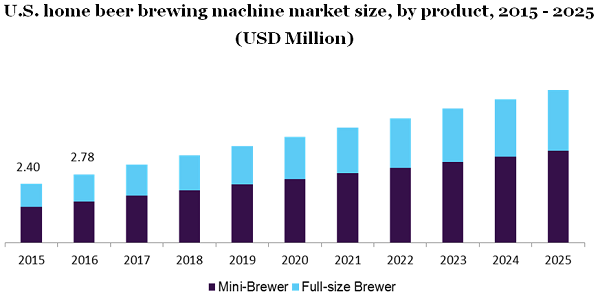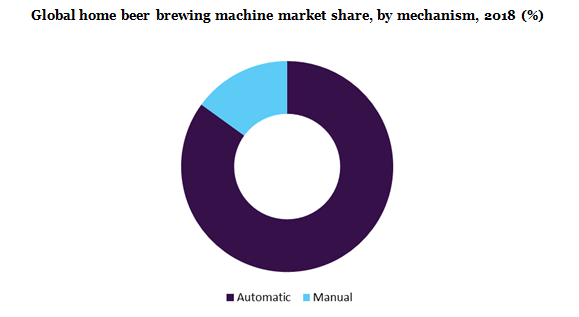- US: +1-408-610-2300
- Toll Free: +1-866-831-4085
- Become a Client
The global home beer brewing machine market size was accounted for USD 12 Million in 2018. The market is expected to witness a CAGR of 13.9%, from 2019 to 2025. This can be attributed to the increasing demand for a homemade beer having a wide range of flavors like chestnut, honey, and malted barley. Moreover, the rising trend for the sale of beer on the premise is anticipated to drive the market growth during the forecasted years.
Homebrewing is gaining high popularity across the globe, especially in the U.S. According to a report, in 2017, the quantity of home-brewed beer produced by residential brewers in the U.S. accounted for 1.4 million barrels. Statistics also stated that 40% of these homebrewers can be considered hobbyists.

Such brewing machines used for beer brewing are being offered in different capacities and sizes and can be easily installed. Moreover, their multi-functionality is expected to boost market demand across the globe.
For example, LG Electronics launched the first beer brewing machine with a capsule design for household purposes. Such machines are durable, efficient, and smart. Thus, they can be used for carrying out processes like boiling, mashing, filtering, and conditioning. Moreover, additional features like touch screen display, digital thermostats, and Wi-Fi connectivity are expected to drive the product demand.
In 2018, the mini brewer segment held the largest market share with 67.1% across the global market. The shifting trend for home brewing is expected to drive the home beer brewing machine market demand across developed countries like the U.S. and Canada. Moreover, a rise in expenditure incurred in R&Ds is expected to boost the market growth for such products in the upcoming years.
The full-size brewer product segment is expected to register the highest CAGR of 14.6% during the forecast period, 2019 to 2025. This growth can be attributed to the rising number of breweries across countries like the U.S., New Zealand, and Australia. Increasing demand for crafted beer among consumers is also expected to drive market growth.
In 2018, the automated mechanism segment held the largest share of around 87.1% across the global market. The rising influence of automated software coupled with improvement in aesthetics of such machines is expected to boost the market growth from 2019 to 2025. For example, PicoBrew has launched a Z-series of automated beer brewing machines to cater to the demands across bars, restaurants, breweries, and pubs.
Such machines are well equipped with features like boiling, mashing, conditioning, packaging, and fermenting. Manufacturers also have started producing products that can be connected to smartphones, tablets, and laptops with the help of Wi-Fi and the internet.

The usage of mobile apps to try new recipes is also gaining popularity among consumers. The manufacturers are also investing in R&Ds for product development and for making technological advances. Such additional features are anticipated to boost the market growth in the upcoming years.
The manual mechanism segment is projected to register a CAGR of 9.7% during the forecasted period, 2019 to 2025. Such products are popular across small-scale breweries. Also, increasing small-scale breweries across European countries and New Zealand and Australia are anticipated to drive the market growth during the forecasted period.
In 2018, the Americas led the global market for a home beer brewing machine with a share of around 55%. This growth can be attributed to the rising consumption of homemade beer among the working population and millennials across developed countries like the U.S. and Canada. Moreover, the rising preference for localized and crafted beer which is being manufactured by micro-breweries is also expected to have a positive impact on the market growth during the forecast period, 2019 to 2025.
Asia Pacific is projected to register the highest growth rate with a CAGR of 16.0% during the forecast period. Rising consumption of beer across developing countries like India and China is expected to drive market growth across this region. Moreover, countries like Australia, China, and India contribute majorly to the market growth owing to shifting trends for the consumption of crafted beer among the population. Moreover, a rise in the number of bars, breweries, and pubs is also anticipated to fuel the market growth in the upcoming years.
The market includes key players like BREWART, Brewie, PicoBrew, Kickstarter, LG Electronics, WilliamsWarn Ltd, and PBC. The rising influence of crafted beer amongst consumers can be considered as the driving factor for the market growth of beer brewing machines. Key players are constantly focusing on expansions, acquisitions, and mergers to boost the sale of their products. For example, MiniBrew launched a fully automated beer brewing machine with features like a remote-controlled, removable keg, and digital display.
|
Attribute |
Details |
|
The base year for estimation |
2018 |
|
Actual estimates/Historical data |
2015 - 2017 |
|
Forecast period |
2019 - 2025 |
|
Market representation |
Revenue in USD Million and CAGR from 2019 to 2025 |
|
Regional scope |
Americas, EMEA, Asia Pacific |
|
Country scope |
U.S., Canada, Brazil, Germany, U.K., Italy, New Zealand, and Australia |
|
Report coverage |
Revenue forecast, company share, competitive landscape, and growth factors and trends |
|
15% free customization scope (equivalent to 5 analyst working days) |
If you need specific information, which is not currently within the scope of the report, we will provide it to you as a part of the customization |
This report forecasts revenue growth at global, regional, and country levels, and provides an analysis of the latest industry trends in each of the sub-segments from 2015 to 2025. For this study, Million Insights has segmented the global home beer brewing machine market report based on product, mechanism, and region:
• Product Outlook (Revenue, USD Thousand, 2015 - 2025)
• Mini Brewer
• Full-size Brewer
• Mechanism Outlook (Revenue, USD Thousand, 2015 - 2025)
• Automatic
• Manual
• Regional Outlook (Revenue, USD Thousand, 2015 - 2025)
• Americas
• U.S.
• Canada
• Brazil
• EMEA
• Germany
• U.K.
• Italy
• the Asia Pacific
• New Zealand
• Australia


Research Support Specialist, USA